How to Build a News App with Ionic 4 & Angular
In this tutorial we’ll be using Ionic 4 to build a news application that makes use of a third-party news API.
Ionic 4 is the latest version of Ionic, a mobile framework originally built on top of Cordova and Angular. Ionic allows users to create hybrid mobile apps with HTML, CSS and JavaScript and their related web technologies.
What makes Ionic 4 the best version yet is that it’s now framework agnostic. This means it’s not dependent on Angular anymore, and you you’ll be able to use it with any framework or library you are familiar with, or with plain JavaScript.
But at the time of this writing, Ionic CLI only supports generating Ionic projects based on Angular, so we’ll be using an Angular/Ionic project to build our news application.
See a hosted version of the application we’ll be building and grab the source code from this GitHub repository.
Prerequisites
Let’s get started with the prerequisites you need to be able to follow this tutorial comfortably.
- You will need to have Node.js and npm installed on your development machine. If that’s not the case, the simplest approach is to go to the official website and grab the binaries for your system. Node.js is not a requirement for Ionic itself, but for Ionic CLI (and Angular CLI behind the scenes) which is the tool that we’ll be using to generate Ionic projects.
- We’ll be using Ionic with Angular, which is based on TypeScript, so you need to be familiar with the basic concepts of TypeScript.
Installing Ionic CLI 4
Ionic CLI 4 is the latest version of the CLI. Open a terminal and run the following command to install it on your system:
$ npm install -g @ionic/cli
Please note that you may need to add sudo before your command in order to install the package globally if you’re using a Debian-based system or macOS. For Windows, if you get any permission errors you can use a command prompt with administrator access. In all systems, you can avoid the npm permission errors by either reinstalling npm with a node version manager (recommended) or manually changing npm’s default directory. See the docs.
Next, you can generate a project based on Angular by running the following command:
$ ionic start
The CLI will interactively ask you for the necessary information about your project, such as the name (Enter newsapp or whatever name you prefer) and the starter template (choose sidemenu which will give you a starting project with a side menu and navigation of the box).
Next press Enter to instruct the CLI to start generating the files and installing the dependencies from npm.
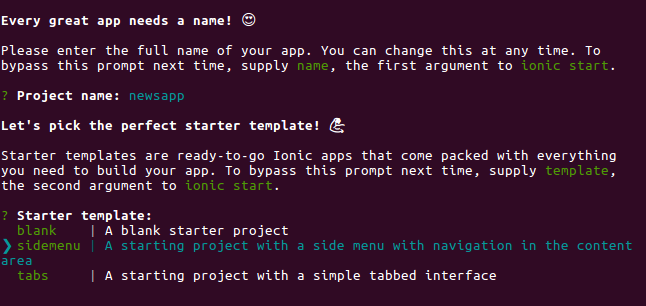
Finally the CLI will ask you if you want to Install the free Ionic Appflow SDK and connect your app? (Y/n). You can type n if you don’t want to integrate the cloud services offered by Ionic.
Appflow is a continuous integration and deployment platform for Ionic developers. Appflow helps developers continuously build and ship their iOS, Android, and web apps faster than ever. You can find more information about Appflow from the official docs.
Next, you can navigate to your project’s root folder and run the following command to start a live-reload development server:
$ cd ./newsapp
$ ionic serve
Your application will be available from the http://localhost:8100 address.
This is a screenshot of the application at this point:
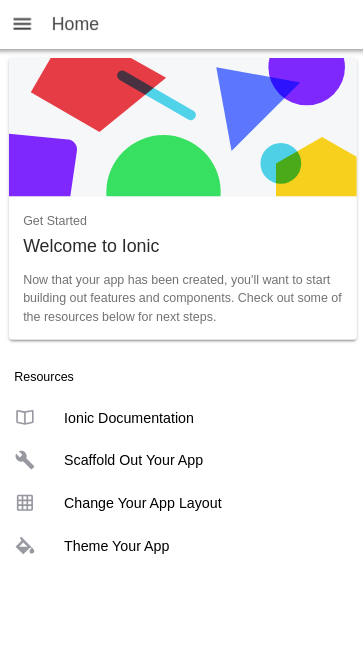
You can see that we already have a pretty decent starting application without doing any development yet. Let’s make some changes to our project.
The project already has two pages — home and list. Leave the first page and delete the list page.
First, remove the src/app/list folder. Next, open the src/app/app-routing.module.ts file and remove the route entry for the list page:
const routes: Routes = [
{
path: '',
redirectTo: 'home',
pathMatch: 'full'
},
{
path: 'home',
loadChildren: './home/home.module#HomePageModule'
},
{
path: 'list',
loadChildren: './list/list.module#ListPageModule'
}
];
We have three routes, one for the empty path that redirects to the /home route, the /home route that displays the home page, and the /list route that displays the list page. You simply need to remove the last object.
You also need to remove the link for the list page from the side menu. Open the src/app/app.component.ts file. Locate the appPages array defined in the component:
public appPages = [
{
title: 'Home',
url: '/home',
icon: 'home'
},
{
title: 'List',
url: '/list',
icon: 'list'
}
];
And simply remove the second object: { title: 'List', url: '/list', icon: 'list'}.
Now, let’s create an about page for our application. In your terminal, run the following command:
$ ionic generate page about
This command will generate a src/app/about folder with a bunch of files, and will update the src/app/app-routing.module.ts file to include a route for the generated page:
import { NgModule } from '@angular/core';
import { Routes, RouterModule } from '@angular/router';
const routes: Routes = [
{
path: '',
redirectTo: 'home',
pathMatch: 'full'
},
{
path: 'home',
loadChildren: './home/home.module#HomePageModule'
},
{ path: 'about', loadChildren: './about/about.module#AboutPageModule' }
];
@NgModule({
imports: [RouterModule.forRoot(routes)],
exports: [RouterModule]
})
export class AppRoutingModule {}
Let’s add a link to the about page in the side menu. Open the src/app/app.component.ts file and update the appPages array:
public appPages = [
{
title: 'Home',
url: '/home',
icon: 'home'
},
{
title: 'About',
url: '/about',
icon: 'help-circle-outline'
}
];
This is a screenshot of the menu at this point:
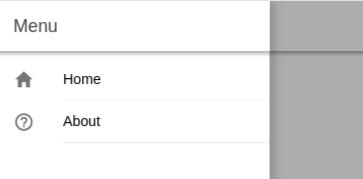
Next, open the src/app/about/about.page.html and add a menu icon to the toolbar of the page, which allows users to open the side menu:
<ion-header>
<ion-toolbar>
<ion-buttons slot="start">
<ion-menu-button></ion-menu-button>
</ion-buttons>
<ion-title>
About
</ion-title>
</ion-toolbar>
</ion-header>
<ion-content padding>
</ion-content>
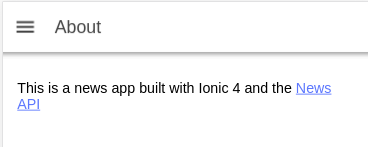
Now let’s add some theming to our application UI.
Open the src/app/about/about.page.html and add a primary color to the menu toolbar and a dark color to the content section:
<ion-header>
<ion-toolbar color="primary">
<ion-buttons slot="start">
<ion-menu-button></ion-menu-button>
</ion-buttons>
<ion-title>
About
</ion-title>
</ion-toolbar>
</ion-header>
<ion-content color="dark" padding>
<p>
This is a news app built with Ionic 4 and the <a href="https://newsapi.org/">News API</a>
</p>
</ion-content>
This is a screenshot of the page:
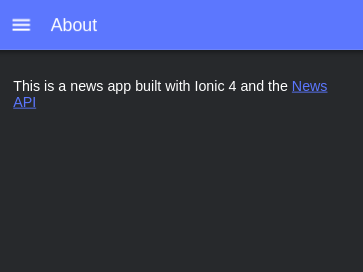
Next, let’s theme the homepage. Open the src/app/home/home.page.html file and replace its contents with the following:
<ion-header>
<ion-toolbar color="primary">
<ion-buttons slot="start">
<ion-menu-button></ion-menu-button>
</ion-buttons>
<ion-title>
Home
</ion-title>
</ion-toolbar>
</ion-header>
<ion-content color="primary">
<ion-card>
<ion-card-header>
<ion-card-subtitle>Welcome to our News App</ion-card-subtitle>
</ion-card-header>
<ion-card-content>
<p>
Enjoy the latest news from TechCrunch.
</p>
<ion-spinner *ngIf="!articles" name="dots"></ion-spinner>
</ion-card-content>
</ion-card>
</ion-content>
Next, open the src/app/home/home.page.scss file and add:
ion-card{
--background: #021b46;
--color: #fff;
}
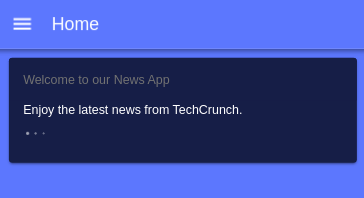
Also, open the src/app/app.component.html file and add a primary color to the menu toolbar:
<ion-toolbar color="primary">
<ion-title>Menu</ion-title>
</ion-toolbar>
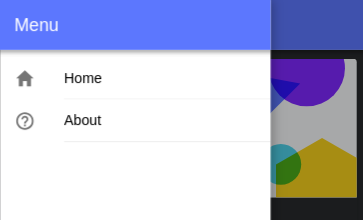
Getting News Data
Let’s now see how you can retrieve news data from the third-party news API available from NewsAPI.org/, which offers a free plan for open source and development projects.
You first need to head here to register for an API key:
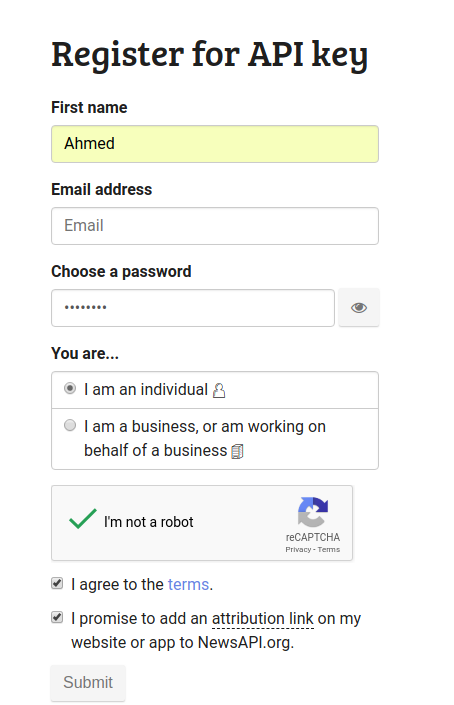
Fill the form and submit it. You should get redirected to the page where you can copy your API key:
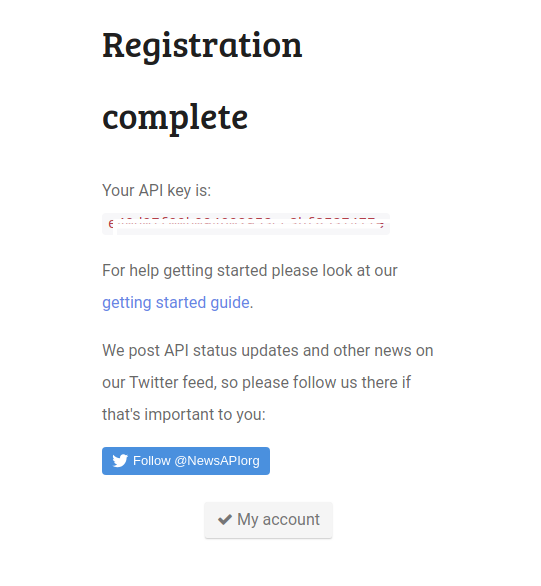
Adding a Service
Next, let’s create a service that will take care of getting data from the news API. In your terminal, run the following command:
$ ionic generate service api
Next, open the src/app/app.module.ts file then import HttpClientModule and add it to the imports array:
// [...]
import { HttpClientModule } from '@angular/common/http';
@NgModule({
declarations: [AppComponent],
entryComponents: [],
imports: [
// [...]
HttpClientModule,
],
// [...]
})
export class AppModule {}
Next, open the src/app/api.service.ts file and inject HttpClient via the service constructor:
import { Injectable } from '@angular/core';
import { HttpClient } from '@angular/common/http';
@Injectable({
providedIn: 'root'
})
export class ApiService {
constructor(private httpClient: HttpClient) { }
}
Next, define an API_KEY variable which will hold your API key from the News API:
export class ApiService {
API_KEY = 'YOUR_API_KEY';
Finally, add a method that sends a GET request to an endpoint for TechCrunch news:
getNews(){
return this.httpClient.get(`https://newsapi.org/v2/top-headlines?sources=techcrunch&apiKey=${this.API_KEY}`);
}
That’s all we need to add for the service.
Open the src/app/home/home.page.ts file and import, then inject, ApiService via the component constructor:
import { Component } from '@angular/core';
import { ApiService } from '../api.service';
@Component({
selector: 'app-home',
templateUrl: 'home.page.html',
styleUrls: ['home.page.scss'],
})
export class HomePage {
constructor(private apiService: ApiService){}
}
Next, add an articles variable that will hold the retrieved news:
export class HomePage {
articles;
Add an ionViewDidEnter() method, where you call the getNews() method of ApiService to retrieve the news:
ionViewDidEnter(){
this.apiService.getNews().subscribe((data)=>{
console.log(data);
this.articles = data['articles'];
});
}
Finally, let’s iterate through the articles variable and display the news on our homepage.
Again, open the src/app/home/home.page.html file and add the following code:
<ion-card *ngFor="let article of articles">
<ion-img src="{{article.urlToImage}}"></ion-img>
<ion-card-header>
<ion-card-subtitle>{{article.title}}</ion-card-subtitle>
</ion-card-header>
<ion-card-content>
<p>
{{article.description}}
</p>
<ion-button ion-button fill="outline" href="{{article.url}}" large>Read full article</ion-button>
</ion-card-content>
</ion-card>
We simply use the ngFor directive to loop through the articles variable and display the image, title, description and URL of each article inside a card component.
This is a screenshot of the result:

You can either host this application on the web (as a PWA) or build it and publish it on the app stores. You can find a live version from this link and the source code in this GitHub repository.
Conclusion
We’ve built a news application from scratch with Ionic 4 and Angular. The application still has plenty of room for improvement, so feel free to play with it and extend it on your own. For example, you could add sources other than TechCrunch, and allow the user to select the source of the news.
